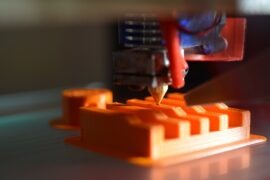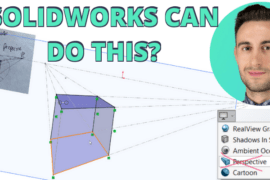
If you’re working for a company that has been using SolidWorks for a while, you may have some procedures on how to go about modeling. However, if you’re starting from scratch or trying to develop a methodology, where do you start? This post gives three ways you can start to develop a methodology to get your models and your team organized while deflecting things people may throw at you.
Modeling Methodologies make my head hurt.
It shouldn’t, so before your head swells to disproportionate measures, lets talk. A methodology is just a big word for how you do stuff. Most are familiar with Bottom-up, mating parts into an assembly, and Top-Down, building parts in an assembly. A simple Bottom-up methodology may look like this attached PDF. As you can see, even for a simple bottom-up approach, there’s a bit of thought that can go into the process.
Bottom-up and Top-down are pretty typical methodologies, but is there something that could work better? Well, while those should be developed also, here are three unique approaches that may provide you with a solution to defining a better methodology for your team.
Bodies as Parts Methodology
Purpose:
To quickly define all parts in one file to develop concepts quickly and reduce the amount of filesMethod:
- Create all geometry in a part.
- When creating feature for another part uncheck Merge Results.
- Right click on Solid Bodies Folder, select Save Bodies and Create Assembly
What this does:
When you save the bodies as parts you get derived parts and an assembly that are still controlled by the part you created everything in. You can also set up templates so all your part properties are pre-defined.Disadvantage:
Unable to modify derived parts and assembly.
Sketches Driven Assemblies Methodology
Purpose:
To keep all definition in a single sketch in order to define interactions between components, reduce mates and automate design.Method:
- Create a Part or Assembly that contains only sketches.
- Put this into an assembly.
- Insert parts and define them using only the sketches.
What this does:
This is an approach to top-down that allows you to control everything from the sketch. If a part changes the other parts will not be affected. The sketch drives everything.Disadvantage:
Makes it difficult to create assemblies that move.
Import models methodology
Purpose:
To simplify component creation by using existing data to define weight, space requirements and interaction between components.Method:
- Import model
- Make simple configuration
- Add properties and weight
What this does:
This allows you to use someone else’s hard work to make your job easier. This can be used for purchased parts or legacy models from a different system. You can also export your models, import them and then do this to reduce file size, but of course you loose all your features.Disadvantage:
Makes it difficult to have multiple configurations.
What do I do next?
After you decide what methodology to use, here’s 5 things to do to bring a smile to your face and a sense of purpose to your team.
- Put it into a document
- Make a quickstep guide
- Control it with Revisions
- Distribute it to your team
- Make sure everyone understands it
Do you have other methodologies that have worked for you?

![6 Types of Civil Engineering Drawings [Detailed Guide]](https://www.solidsmack.com/wp-content/uploads/2023/12/Civil-Engineering-Drawings-270x180.jpeg)

